I came across this
interesting story from Joe Rouse at
The Horse's Mouth:
"Darwin's Law Circumvented by USCG"Last Thursday we were doing the California Bash up from San Diego
approximately 10nm off Carmel. While monitoring ch. 16 I heard a
vessel doing long counts to ten for a USCG helicopter. The skipper
was saying, "ONE...TWO...THREE…" etc. They repeated this three
times over the course of about 20 minutes. I figured that the helo
was trying to home in on their location using RDF. This sounded
like some kind of emergency so I stayed tuned.
After a few more minutes I discovered that the sailing vessel
Celcion (Celcion is Latin for "are we there yet") was lost and that
the helo was on its way to lend assistance. Upon finding the
desperately lost voyager the helo then hovered overhead in order to
provide the adventurous captain with his lat/long position. The
coordinates were repeated several times due to mis-something. The
skipper then asked where he was. The USCG helo said "you're six
miles from Monterey." The skipper mumbled something about wanting
to go to Half Moon Bay and "could you point me in the right
direction, and I think I have a "map" of Monterey someplace". The
helo pilot was not about to give this guy directions, and wisely
so. He strongly urged the captain to seek an escort into Monterey
for the evening (sunset was another two hours away). The skipper
accepted even though he was a wee bit embarrassed at this point.
The pilot contacted USCG Monterey and requested a rescue boat be
dispatched to the scene. I being only about 8nm away also offered
my assistance. The pilot asked if we could steam towards Celcion's
position and act as another asset if needed. We agreed to do what
we could.
About 45 minutes later the USCG rescue boat arrived. We were now
3nm away from Celcion. Communication between the coasties and the
skipper were a little confused. The coasties asked several times if
he or his crew had suffered any injuries. The skipper finally
understood and said "Only my pride". Eventually the coasties
escorted this rather fortunate skipper and his crew into Monterey
for the evening while we went back to bashing up the coast.
Joe's comments were:"It appears that the skipper of the Celcion left SF Bay for a trip toHalf Moon Bay and wound up near Monterey totally lost and confused. I wonder if this is how Gilligan's Island started?1.5 Hours of USCG Helicopter flight time = $20,0003 Hours of USCG rescue boat time = $5,000Spending an unexpected weekend in Monterey with the help of UStaxpayers and the Coast Guard = PRICELESS"
What I don't get is why the bill for Coast Guard service in frivolous situations like this is not sent along to the owner or operator of the vessel in trouble. When skiers get themselves in similar situations they are often billed for the cost of their rescue, even in the US. A quick Google search yielded an example from
from Vermont where each of the four skiers involved was assessed $4,177.87 to cover the cost of the rescue from the woods near Killington. For ski vacations in Europe, travellers can take out insurance to cover the high cost of a potential rescue.
Why should taxpayers cover the cost of the mistakes of an inexperienced sailor in a similar situation?
 And went over to Lake Massapoag:
And went over to Lake Massapoag: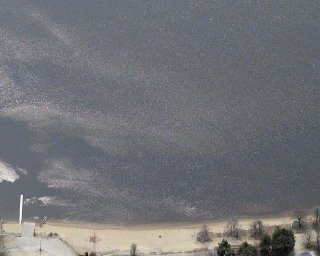 I launched the boat from the boat ramp in the photo above. The wind was a shifty and variable northeasterly. While I was rigging, the local high school sailing coach Bob showed up. He had noticed my sail and decided to see who the crazy sailor was. He invited me to come along to the Thursday night Laser racing and also the Sunday handicap racing. So now I can race on a lake within 10 minutes of my house.
I launched the boat from the boat ramp in the photo above. The wind was a shifty and variable northeasterly. While I was rigging, the local high school sailing coach Bob showed up. He had noticed my sail and decided to see who the crazy sailor was. He invited me to come along to the Thursday night Laser racing and also the Sunday handicap racing. So now I can race on a lake within 10 minutes of my house.
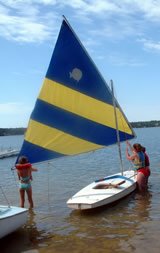
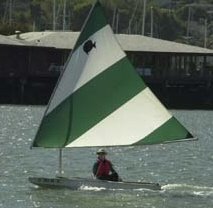
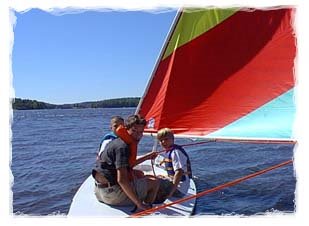
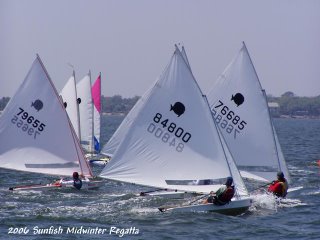

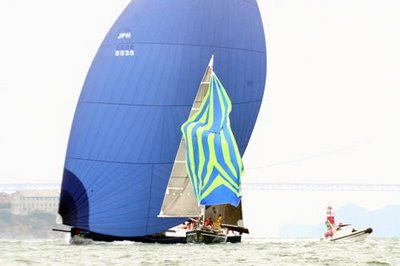
So are you in another boat's wind shadow when its wind indicator is pointing at you, or when your wind indicator is pointing at them?
4:30 PM
Wind indicators point to windward, but they are affected by apparent wind, so a more accurate description would be that you are potentially in someone's wind shadow when you are on the imaginary line drawn straight downwind from the windward boat's sail plan.
5:11 PM